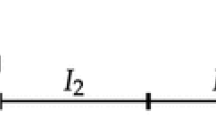Abstract
Given a graph G=(V,E) with strictly positive integer weights ω i on the vertices i∈V, an interval coloring of G is a function I that assigns an interval I(i) of ω i consecutive integers (called colors) to each vertex i∈V so that I(i)∩I(j)=∅ for all edges {i,j}∈E. The interval coloring problem is to determine an interval coloring that uses as few colors as possible. Assuming that a strictly positive integer weight δ ij is associated with each edge {i,j}∈E, a bandwidth coloring of G is a function c that assigns an integer (called a color) to each vertex i∈V so that |c(i)−c(j)|≥δ ij for all edges {i,j}∈E. The bandwidth coloring problem is to determine a bandwidth coloring with minimum difference between the largest and the smallest colors used. We prove that an optimal solution of the interval coloring problem can be obtained by solving a series of bandwidth coloring problems. Computational experiments demonstrate that such a reduction can help to solve larger instances or to obtain better upper bounds on the optimal solution value of the interval coloring problem.
Similar content being viewed by others
References
Bouchard, M., Čangalović, M., & Hertz, A. (2009). About equivalent interval colorings of weighted graphs. Discrete Applied Mathematics, 157, 3615–3624.
Čangalović, M. (1989). Some new combinatorial optimization algorithms applied to timetabling problems. Ph.D. thesis, University of Belgrade, Serbia (in Serbian).
Čangalović, M., & Schreuder, J. A. M. (1991). Exact coloring algorithm for weighted graphs applied to timetabling problems with lectures of different lengths. European Journal of Operational Research, 51, 248–258.
Clementson, A. T., & Elphick, C. H. (1983). Approximate coloring algorithms for composite graphs. Journal of Operational Research Society, 34, 503–509.
Deuber, W. A., & Zhu, X. (1996). Circular colorings of weighted graphs. Journal of Graph Theory, 24, 365–376.
Fabri, J. (1979). Automatic storage optimization. In: ACM SIGPLAN notices: proceedings of the 1979 SIGPLAN symposium on compiler construction, Vol. 14/8 (pp. 83–91).
Garey, M. R., & Johnson, D. S. (1979). Computers and Intractability: A Guide to the Theory of NP-Completeness. Freeman: New York.
Ginsberg, M. L. (1993). Dynamic backtracking. Journal of Artificial Intelligence Research, 1, 25–46.
Lim, A., Zhu, Y., Lou, Q., & Rodrigues, B. (2005). Heuristic methods for graph coloring problems. In: Proceedings of the 2005 ACM symposium on applied computing (pp. 933–939). Santa Fe, New Mexico.
Prestwich, S. (2002). Constrained bandwidth multicoloration neighborhoods. In: Proceedings of computational symposium on graph coloring and its generalizations (pp. 126–133). Ithaca, NY, USA.
Punter, A. (1976). Systems for timetabling by computer based on graph coloring. Ph.D. thesis, C.N.A.A., Hatfield Polytechnic.
Sakaki, T., Nakashima, K., & Hattori, Y. (1976). Algorithms for finding in the lump both bounds of the chromatic number of a graph. The Computer Journal, 19, 329–332.
Author information
Authors and Affiliations
Corresponding author
Rights and permissions
About this article
Cite this article
Bouchard, M., Čangalović, M. & Hertz, A. On a reduction of the interval coloring problem to a series of bandwidth coloring problems. J Sched 13, 583–595 (2010). https://doi.org/10.1007/s10951-009-0149-1
Published:
Issue Date:
DOI: https://doi.org/10.1007/s10951-009-0149-1




